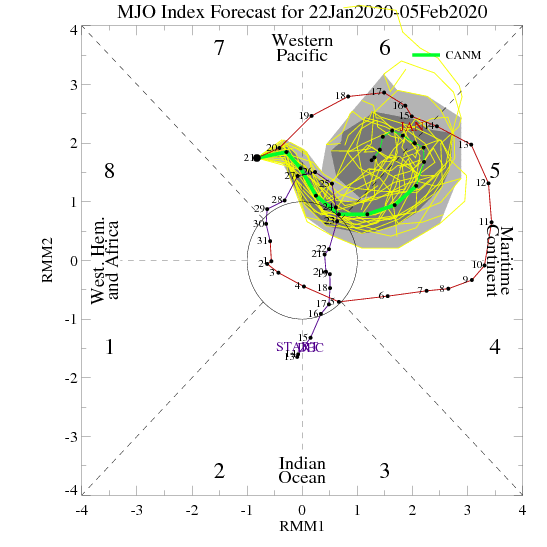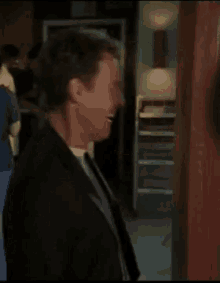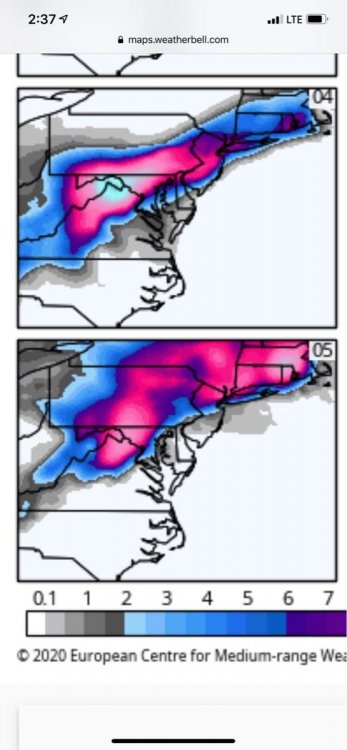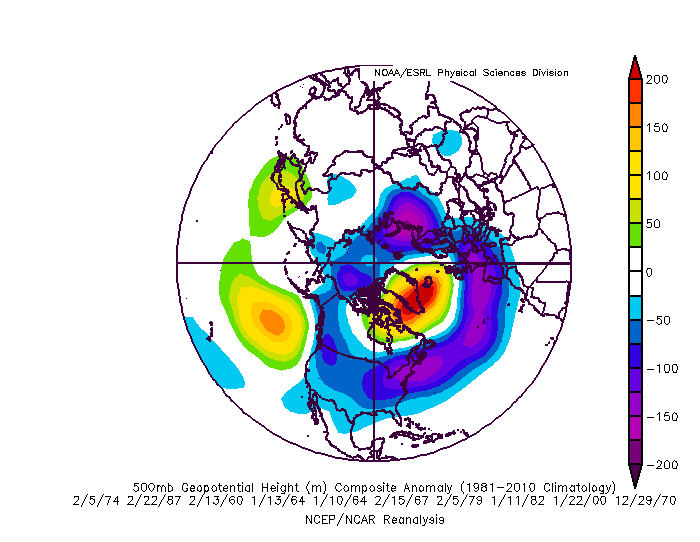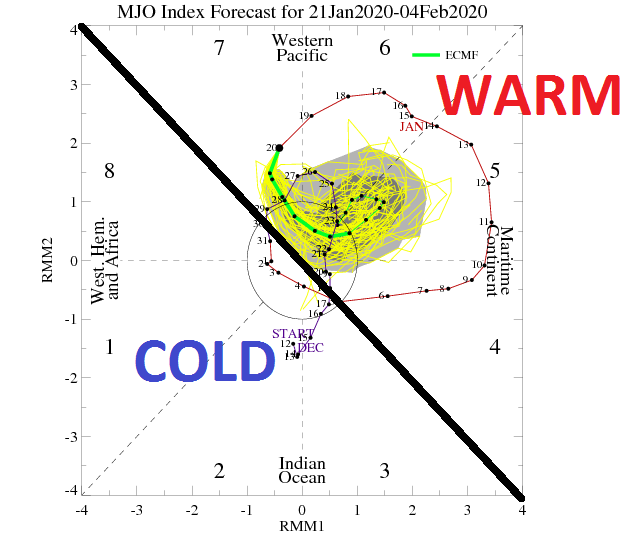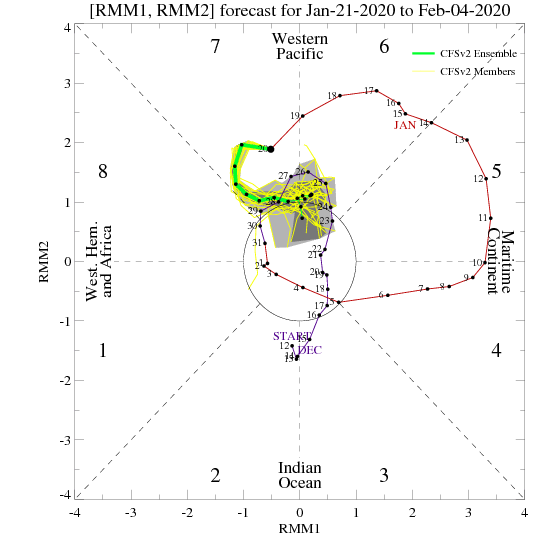-
Posts
26,460 -
Joined
-
Last visited
Content Type
Profiles
Blogs
Forums
American Weather
Media Demo
Store
Gallery
Everything posted by psuhoffman
-
-
He exaggerated the cold but his point is true. In 2017/18 we had a period from Dec 26-Jan 15 well below normal temps and away from the immediate coast it did very few any good wrt snow. It’s was a very dry period. I was below freezing that entire 3 week stretch and had like 4” from 3 minor events to show for it. And that isn’t the only such period. We have had other extended cold dry stretches. Since we aren’t a cold location that’s not common but it’s not a crazy anomaly. And we have had a lot of warm wet patterns that didn’t produce any snow. Truth is we need cold AND precip to get snow. They are equally important. From a long distance yes cold seems a better play because cold dry is numerically less likely than warm. But once a pattern is staring us in the face and it’s obvious it’s a dry suppressed one the whole “at least it’s cold” thing doesn’t bring me any comfort. Now some like cold. That’s totally ok. But if you like snow and don’t care about the thermometer than there are certain pattern markers we need within a cold look to get snow.
-
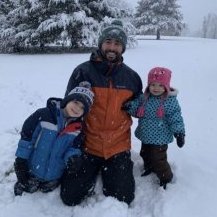
Mid January/Mid February Medium/Long Range Discussion
psuhoffman replied to WinterWxLuvr's topic in Mid Atlantic
That “better” look is so tenuous. Guidance relaxes the AK vortex some and builds just enough ridge barely near the NAO domain and in the Southwest to squeeze a cold shot down the middle between the two ridges. But all of the changes are barely enough and if any of them is wrong it’s just more of the same. I don’t feel good until I see either the AO/NAO really start to flip or that Vortex away from AK. -

January 2020 General Discussions & Observations Thread
psuhoffman replied to Rtd208's topic in New York City Metro
We have this debate in the mid Atlantic sub too. First of all normal and avg aren’t the same. If you look at what a standard deviation for snowfall is it will likely give you a wide range. But the issue is to get that avg you need above and below avg years. If all you ever got was above avg then avg years your avg would perpetually rise. So if you recently had a string of mostly above avg winters it is normal to have a string of below avg ones to balance it out. -
I can see both sides. @RevWarReenactor, @losetoa6 lives near me. Our climo up here can be good for snow and even keeping snowcover into late March. I’ve even seen decent snow in April but by then keeping in on the ground long is a lost cause. But I had almost a week of snowcover the last week of March 2018. Also a week of snow Otg in Mar 2017 and 2015. On the other hand if I were where you are I likely wouldn’t really see March as a winter month either. And without that one nice wintery few days up here earlier this month I probably would be a lot less content right now so I get where you are at.
-

Mid January/Mid February Medium/Long Range Discussion
psuhoffman replied to WinterWxLuvr's topic in Mid Atlantic
Analysis doesn’t make it snow. Maybe some of us enjoy analyzing the pattern no matter the outcome. -
Maybe it looks close for our area but honestly I’m not invested enough to dig that deep.
-

Mid January/Mid February Medium/Long Range Discussion
psuhoffman replied to WinterWxLuvr's topic in Mid Atlantic
Couldn’t that be true of everyone? It probably would be more effective to pool global resources into one system and crate the best single combination. Yes there might need to be more than one model (or a beefed up ensemble system) but having tons of inferior models floating around just adds noise imo. But getting that kind of coordination and cooperation is difficult in anything. -
euro ensembles... thing is...the 1-3" of snow it has in our NW regions is not from a lot of small hits...its from a couple massive ones but with the vast majority showing nothing. So basically there is a very slim chance that if everything went exactly right...they do that by having a perfect H5 track and then bombing a slow moving coastal and deforming the hell out of us...how often does that actually happen here? then maybe we get a big storm...but the high probability is just a rainstorm pretty much everywhere except the highest elevations or north of our region.
-
-

Mid January/Mid February Medium/Long Range Discussion
psuhoffman replied to WinterWxLuvr's topic in Mid Atlantic
It might encroach the southern edge of the NAO domain some...but its not the kind of look that will influence the pattern the way we need. A better sign is the guidance ejecting the AK vortex...although todays GEFS seems to take a "step back" on that. I don't care about the blue over us if there is still a AK and Greenland Vortex combo...it will not be cold enough in all likelihood regardless of a day 15 look. This is a composite of warning level snowfalls at BWI with a somewhat similar Pac look to this year. Notice where we need the ridging in the NAO region to be. -

Mid January/Mid February Medium/Long Range Discussion
psuhoffman replied to WinterWxLuvr's topic in Mid Atlantic
The ridging I see is mostly south of the NAO domain. -

Mid January/Mid February Medium/Long Range Discussion
psuhoffman replied to WinterWxLuvr's topic in Mid Atlantic
But it’s close day 10 to a flood -

Mid January/Mid February Medium/Long Range Discussion
psuhoffman replied to WinterWxLuvr's topic in Mid Atlantic
What is messing this up in the broader sense is the longwave pattern. The upper low is stuck under blocking in canada yes... and that forces a south track of that feature (considering where it starts out) and that is why a ridge near Hudson Bay can sometimes work for us with a crappy background state... but in this case the wall to wall lower heights all across from AK to the NAO is blasting warm air across the continent. The problem isnt really the upper low. I guess it is if you were hoping to salvage any frozen in spite of the fact the antecendent airmass is a rotting POS. Then yea...the only way was to get a damn perfect H5 track and a bombing surface low to our east. But that is so rare. The real problem is the surface low is going to try to seek out the baroclinic zone and that is way way way north. So even with a pretty ok upper track the surface low is going to cut, on some runs it even ends up NW of the upper low for a time. That is why we see those wacky outcomes. If there was any cold at all this would be a big snowstorm because the surface low would stay to the southeast of the upper low along the boundary. We are left praying for some 1/100 perfect upper low to track under us and have an amplified enough system to create its own cold air...how often does that work. More for you than DC I guess...but its the larger picture that is the real problem imo not the micro level issues with the H5 track. -

Mid January/Mid February Medium/Long Range Discussion
psuhoffman replied to WinterWxLuvr's topic in Mid Atlantic
-

Mid January/Mid February Medium/Long Range Discussion
psuhoffman replied to WinterWxLuvr's topic in Mid Atlantic
-

Mid January/Mid February Medium/Long Range Discussion
psuhoffman replied to WinterWxLuvr's topic in Mid Atlantic
If the heat transport from those waves is not directed towards the mid/high latitudes in the northern hemisphere its irrelevant. I think it was bluewave who showed a great loop where it was obvious the majority of the energy was being muted from transporting poleward in the NH. Way more was being directed into the SH actually. -
He has become a total joke. He was always a hype machine and biased cold/snowy but his discussions and videos used to at least be an interesting and often educational experience. He would discuss different looks and options. Now all he does is release propaganda where he cherry picks one run that supports his predictions or rants about his anti climate change agenda. And he has become even more ridiculous in the lengths he will go to support his forecast. For example using a year like 1978 when we got a cold period during a warm mjo rotation to justify his ideas. He is either crazy if he really doesn't see the difference between a season with a cold base state, canonical nino, weak PV...and what we have now. Using weak warm MJO waves in very cold winters is NOT a comp to seeing a super charged warm phase MJO wave in an already warm background state. So he has either lost it...or he is flat out lying to everyone to support a forecast he knows is going to bust.
-

Mid January/Mid February Medium/Long Range Discussion
psuhoffman replied to WinterWxLuvr's topic in Mid Atlantic
Since mid December...when our climo really starts...while we have had 3 disticntly different patterns...they all featured either an AK vortex or a ++++NAM. That combo won't work. Yes we have had different factors shifting around...but the issue is we got one of the worst combinations of a nina/nino that in concert are killing us. -
Maybe...but what you are seeing on the 300 hour guidance is not really a true -NAO or NAM state flip. It's the ridge under the TPV getting caught in a sqeeze play between the shifting AK vortex and the TPV over and north of Greenland. I do not see the wave breaking necessary to really force a permanent NAM state change from that...as of yet. The feature you are seeing isnt bad...and if the AK vortex does drop into central North America that is good... but I am not as hopeful that what your seeing day 15 is the permanent NAM state flip we need. I do think there is a chance that does happen, but its likely later in Feb or March if at all. We kind of have a mix of signals...we talked about in the fall how there are so many conflicting signals...but the combinations isnt going our way. We wondered how it would play out...and we did get a mix of some nino and nina like pattern features. Problem is the ones that ended up dominant were the worse of both worlds. We got the ridge near Hawaii and +NAM associated with a nina, and we got some central Canada ridging associated with a nino, but that combination isnt really going to cut it. Often in a nina base state winter we do see a more favorable NAM state phase change towards the end. My feeling is that the shortening wavelengths aid in heat transport and wave breaks attacking and disrupting the stable PV and make it more possible to get some blocking later. Shorter wavelengths can also make it more possible to get a fluke storm without help up top. So there is some support to the idea that the current mess we are in could change but that typically doesn't happen until later in Feb or even more common in March.
-
Don't disagree with your points... and I would also recommend anyone who gets emotionally invested (a lot of people) in day 10 forecasts should take a break... but for me personally I can look at long range...knowing full well how low probability things are, analyze the permutations of where the pattern could be going based on the limited NWP clues and seasonal tendencies, without it driving me crazy when particular results I want do not happen. But for most who cannot do that...avoiding long range is probably a good idea.
-

Mid January/Mid February Medium/Long Range Discussion
psuhoffman replied to WinterWxLuvr's topic in Mid Atlantic
We cannot overcome an AK vortex if the NAO is raging positive. We can and have snowed with an AK vortext...especially as we get later in winter...if the NAO is negative to block the pacific onslaught. But with both features the pac obliterates any mid level cold across north america. Likewise we can overcome a +NAO with an epo ridge. But if we continue to see an AK vortex AND a +NAO we are screwed. Yes I said SCREWED so here comes a post from you know who complaining about "how dare I declare winter over". Joking aside, maybe one or both of those features change from here on out, I would have more hope in the AK vortext than the NAO, but we are losing valuable prime climo everyday and odds of ending up with anything other than a bad winter are decreasing, not that I am surprised by that fact. But there is always "hope", there have been very rare cases where the pattern went through a complete reversal late...had the flip in 2018 happened maybe 2 weeks earlier we probably would remember that as one of the great turnaround years also. But when its so hard to get snow here to begin with...spending a huge chunk of our prime snow window in a shutout total crap pattern really makes it difficult. ETA: the only reason any of these threats the next 10 days are "close" is that Hudson Ridge. Those can sometimes overcome the larger crappy base state. It was actually the feature most at cause for our "bad pattern snowstorms". But even with that...we would need to get lucky with an absolutely perfect track amplified h5 system...and even then I am not so sure if it would work in the cities. -
DC could get 2" of snow the whole rest of winter and that would make your prediction true.
-
This is what I am chasing at this point...


